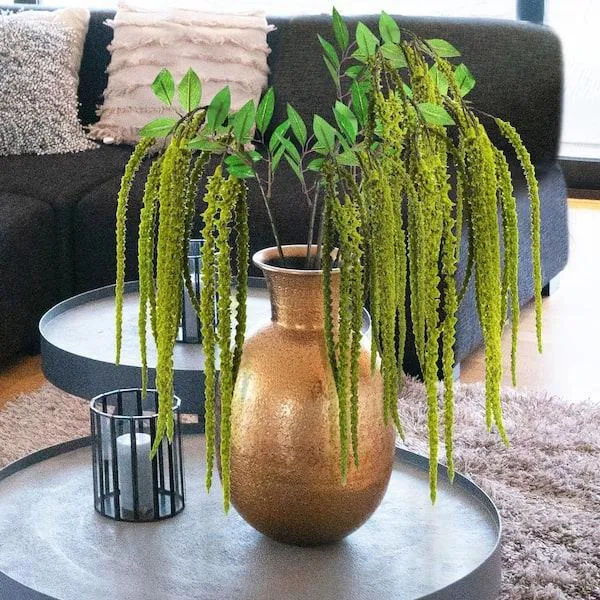The Best Hanging Plants to Suit Any Indoor Space
Whether you’re looking to brighten up a dreary corner or add some life to an apartment with limited floor space, hanging plants are a versatile solution. Their compact growth habit allows them to fit into small areas that traditional floor plants can’t reach. In this article, I’ll explore some top hanging plant options and provide tips on caring for them based on over 15 years of gardening experience.
Pothos
Pothos, or devil’s ivy, is one of the hardiest and easiest hanging plants to care for. Its trailing vines grow rapidly to fill out baskets and hangers. I’ve had pothos hanging in every home I’ve lived in simply because it thrives with so little maintenance. These plants can go weeks between waterings and tolerate low light levels. They’re basically impossible to kill! Place a pothos in any out-of-the-way corner and forget about it.
From my experience, golden pothos and marble queen pothos varieties have beautiful variegated leaves that light up dull areas. Consider starting with a four-inch pot and within a year it will cascade over the sides of any container. Pothos purifies indoor air too, so it’s great for bedrooms and living rooms.
Philodendron
If you want something a little more substantial than pothos, philodendrons make lovely hanging plants. Their thick, glossy leaves come in an array of colors from deep green to creamy white variegation. I have a philodendron selloum (Thaumatophyllum bipinnatifidum) that’s probably close to 15 years old! It continues producing new leaves and hanging shoots to trail down and around its basket.
Philodendrons prefer slightly drier soil than pothos but still thrive on infrequent waterings. Many varieties can even grow in low-light office spaces. Consider heartleaf (Philodendron hederaceum), brazil (Philodendron erubescens), or prince of orange (Philodendron bipinnatifidum) for their graceful weeping forms.
English Ivy
No other hanging plant screams “indoor jungle” quite like English ivy (Hedera helix). Allow it to trail down from a high hook or along shelves and it will eventually cover the space in shiny dark green foliage. English ivy thrives outdoors in zones 6-11 as well, so gardeners in warmer climates can enjoy it year-round as a landscape groundcover.

Its dense vines make it great for covering unsightly walls or bare areas. Just be warned that English ivy can become invasive if conditions are right, so kind of contain it in a hanging container. With infrequent water and bright indirect light, you’ll have a head-turning indoor greenery in no time.
Spider Plant
For a low-maintenance option with loads of visual impact, spider plants (Chlorophytum comosum) are hard to beat. Their long arching grass-like leaves seem to reach out randomly from hanging baskets or containers. Within a few months, you’ll see tiny plantlets called “spiders” forming at the end of each leaf. You can clip these off to start new spider plants!
Spider plants flourish in average household conditions. I leave mine by a west-facing window where they get morning sun. They thrive on neglect too – I can go a couple weeks between thorough waterings. Plus the flowers offer sprays of miniature white blooms that add to their charm.
Prayer Plant
For a truly unique hanging plant, look no further than calathea or “prayer plants.” Their arrowhead-shaped leaves come in a rainbow of colors from deep burgundy to creamy white stripes. But what really sets them apart is their unusual circadian rhythm – the leaves fold inward from dusk to dawn like hands in prayer. It’s amazing to watch each evening!
C. orbifolia ‘Medallion’ is a favorite variety with its large ruffled leaves. While calathea prefer slightly higher humidity than many other hanging plants, their prayers regularly remind you when they require water. Simply mist the foliage often and keep soil consistently moist for these dramatic beauties.
Peperomia
Small-leaved trailing peperomias add sprinkles of texture and color in hanging pots. Try P. polybotrya with heart-shaped leaves aging from lime green to rosy pink. P. prostrata ‘Nanouk’ has adorable fuzzy oval leaves perfect for brightening up desktops or shelf spaces. And P. caperata glows with cream-and-green foliage like vines of tiny flowers.

Peperomias tend to prefer warmer homes and rooms over chilly drafts. They also like slightly drier conditions between waterings compared to other hanging plants. Overall though, peperomias thrive on neglect and shower leaf surfaces with moisture periodically for healthy growth.
Caring for Hanging Plants
Now that you’ve explored some top hanging plant options, here are a few tips to keep them healthy:
- Watering: Allow soil to partially dry between thorough mistings or waterings. Check soil moisture by inserting a finger an inch deep. Overwatering causes root rot.
- Light: Most prefer bright indirect sunlight. Rotate hanging baskets weekly so all sides receive equal light exposure. Avoid direct afternoon sun which can scorch leaves.
- Fertilizing: Use a diluted liquid houseplant fertilizer monthly during spring and summer. Increased growth means higher nutritional needs.
- Pruning: Periodically trim leggy vines and remove dead or diseased foliage to promote bushier growth. Cutting back by 1/3 encourages new shoots.
- Repotting: Transplant into slightly larger pots as roots fill the container. Repot annually in early spring using a well-draining potting mix.
- Pests: Check regularly for signs of pests like spider mites or mealybugs. Isolate and treat promptly using neem oil, insecticidal soap, or systemic granules.
By following these care tips, your hanging plants should thrive for years to come. Many are even purported to improve indoor air quality according to recent studies. So try some today to breathe new life into lackluster walls and corners!
Consider placing hanging plants near golden pothos in entryways to absorb toxins and harmful VOCs from shoes. Spider plants, English ivy, and peperomias also top the EPA list of effective houseplants. Meanwhile, peace lilies, Chinese evergreens, and snake plants reportedly reduce indoor mold and bacteria. No matter which variety you choose, hanging plants present an easy way to decorate and detoxify living spaces naturally.
With a little TLC, many started as small 4-inch pots can mature into impressive floor-grazing specimens. I still have the original pothos and spider plants given to me over 15 years ago that now dang nearly to the floor! Hanging plants offer long-term payoffs both aesthetically and functionally. Give them a try – I’m sure you’ll be pleased by their purifying presence for years to come.
Let me know if you have any other questions! Hanging plants truly bring life, color and cleaner air to indoor spaces. Finding the right options to suit your needs is half the fun. With a little care, they’ll hang around looking good for a long, long time.

Best Hanging Plants for Your Home
| Plant | Size | Light Needs | Water Needs | Care Tips |
|---|---|---|---|---|
| Pothos | Small to Medium | Low to Bright Indirect | Allow Soil to Dry Between Waterings | Easy to Care For, Tolerates Neglect |
| Philodendron | Small to Large | Low to Medium | Water When Top Inch is Dry | Tolerates Low Light, Toxic to Pets |
| Spider Plant | Small | Bright Indirect | Allow Soil to Dry Before Watering | Produces Baby Plants, Air Purifying |
| English Ivy | Small to Large | Low to Bright Indirect | Keep Soil Slightly Moist | Vining Trails Look Beautiful, Pet Friendly |
| Peperomia | Small | Low to Medium | Allow Top Inch of Soil to Dry | Colorful Varieties, Tolerates Low Light |
FAQ
-
What types of hanging plants are best for indoor use?
Ivy, pothos, spider plants and philodendrons are kinda plants that do very well hanging indoors. They don’t need much light or water, so they’re sort of low maintenance. Peace lilies and Chinese evergreens also hang out well in places with low or indirect light.
-
How do I care for hanging basket plants?
You’ll basically want to water hanging plants whenever the soil becomes dry to the touch. Be careful not to overwater them though, since too much moisture can cause root rot. Also, you’ll need to occasionally feed them with planting fertilizer during the growing season. But I’m not really sure – does anyone have tips for caring for hanging plants long-term?
-
What is the best way to hang plants?
There are a number of different methods for hanging plants. You can use ornamental hooks, chains, metal baskets, or cables – it really depends on the size and weight of the containers. Metal hanging brackets are usually pretty sturdy. However, jute or natural fiber ropes also work well and add a more rustic appeal. I’ve even seen some peopleMacGyver plant hangers out of old boots or baskets before!
-
How high should hanging baskets be hung?
Most sources say to hang baskets somewhere between 2 to 5 feet off the ground. Any lower and they may get knocked around or broken. But any higher is kind of a pain if you need to water or tend to the plants frequently. I’ve read that 3 to 4 feet is generally a sweet spot height-wise. Then again, the perfect height depends on things like the size of the room and basket.
-
What kinda plant should I avoid hanging?
You’ll want to be careful about hanging any plants that are particularly heavy when watered. So big succulents or heavy tropicals might not work out so well long-term. Plants that require a lot of sunlight may also struggle if they’re hung in shade. Ferns and coleus also tend to do better planted in the ground versus hanging. But otherwise, most trailing or vining houseplants should hang out just fine!
-
How do I encourage hanging plants to trail?
When you first put trailing plants in hanging baskets, it helps to gently guide the stems over the edges so they form a cascading shape from the start. You can also use plant ties or pins to train stems in the direction you want. Be patient, as it may take some time for them to fully develop that gorgeous spilling effect. Another possible trick is to occasionally turn the planter – somehow the plants seem to get the hint to trail all around that way.

-
What are some benefits of using hanging plants?
Hanging baskets can really liven up a space, even if you’re running low on floor or table space. They also help spruce up areas that don’t get much direct sunlight. On the other hand, hanging plants are great for small patios, balconies or porches since they make the most of vertical surfaces. Perhaps the main advantage is how amazing hanging greenery can be for brightening dull corners and lifting your mood. Who doesn’t love coming home to a lush explosion of foliage hanging all around?
